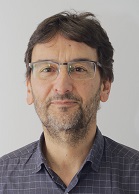Roberto Sarmiento: Award of Excellence to the University Research Career of the ULPGC 2023.
On Thursday 27 April, the ULPGC awards for research excellence for the 2023 call for applications were presented. Roberto Sarmiento, Professor of Electronic Technology, received the University Research Career Award.

Roberto Sarmiento Roberto Sarmiento studied Electrical and Electronic Engineering at the Polytechnic University of Las Palmas. Upon completing his studies in 1984, he joined as a Course Instructor in the Physics Department of the same University. In 1986, he became part of the Electronics Department, then known as the Department of Electronics and Telecommunications, teaching at the ETSII (now the School of Industrial and Civil Engineering). In 1991, he presented his doctoral thesis supervised by Dr. Antonio Núñez Ordóñez in microelectronic design with III-V technologies, specifically Gallium Arsenide (GaAs).
In 1989, he participated in the founding of the Escuela Técnica Superior de Ingeniería de Telecomunicación, a center promoted and directed by Professor Antonio Núñez, serving as the deputy director of Academic affairs. Between 1994 and 1998, he was the director of this center, during which the Telecommunications Engineering degree, with its two cycles, was definitively established at the University of Las Palmas de Gran Canaria. During this period, he also co-founded the Center for Applied Microelectronics (CMA) at ULPGC, which in 1997 became the Institute of Applied Microelectronics (IUMA), the first University Institute affiliated to the University of Las Palmas de Gran Canaria. Since the foundation of the CMA, and later in the IUMA, he has been the director of the Division of Integrated Systems Design (DSI).
In early 1993, he obtained the position of Associate Professor and received a scholarship within the “Programa Sectorial de Becas de Formación de Profesorado y Personal Investigador en el Extranjero” to carry out a stay at the University of Adelaide in Australia. This stay was the result of collaboration established years earlier with Professor Kamran Eshraghian, one of the pioneers of CMOS technology and, at that time, one of the pioneers of the use of Gallium Arsenide technology in digital systems. Due to his work and collaborations worldwide, the CMA became a reference center in GaAs technology, obtaining funding from national plans, European projects, and industry. Among the latter, it is worth noting the partnership that Roberto Sarmiento established and directed between 1997 and 2001 with the California-based company Vitesse Semiconductor Corporation (now acquired by Microchip), which was cited as an example of University-Industry transfer on numerous occasions.
In 1998, he obtained a University Chair in the area of Electronic Technology at the University of Las Palmas de Gran Canaria. That same year, he was appointed Vice-Rector for Academic Organization and Teaching Staff at the University of Las Palmas de Gran Canaria, by Rector Manuel Lobo Cabrera. He held this position until 2004, two years after the re-election of the Rectoral team in 2002. For several years, he served as an advisor to the Advisory Council for Science, Technology, and Innovation of the Government of the Canary Islands (2005 – 2009) and the Canary Islands Agency for Research, Innovation, and Information Society (2011 – 2012). He also advised the Directorate General of Universities and Research of the Government of the Canary Islands on program contracts (2005 – 2008). He has also served as an advisor to the Australian Research Council and as a member of the Advisory Board of the Centre for Very High-Speed Microelectronics Systems at Edith Cowan University (Australia). Since 2011, he has been a member of the program committee of DCIS (Design of Circuits and Integrated Systems), the only conference in the field of microelectronics at the national level.
Roberto Sarmiento has published over 300 articles in journals, book chapters, and conference papers and has participated in more than 60 projects and agreements funded by public bodies and private entities. In the last decade, his activity has focused on innovation projects in the area of designing embedded electronic integrated systems in satellites, leading several projects funded by the European Space Agency (ESA), the European Union, and collaborating with the leading companies in the sector (including Thales Alenia Space, Sener, GMV, Airbus, Teletel, etc.). In this business activity, he maintains six research contracts, electronic circuits (IPs) have been developed that are used by the entire European space industry, and he participates in space missions such as Copernicus and more specifically in the CHIME instrument (Copernicus Hyperspectral Imaging Mission For The Environment) which will be incorporated into future Sentinel satellites.

Image source: ULPGC Archive